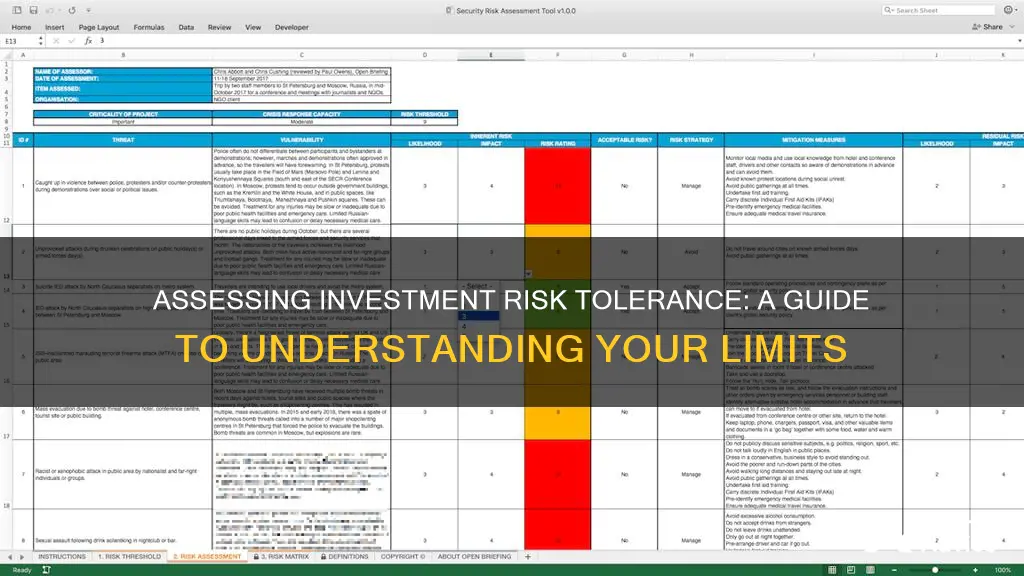
When it comes to investing, it's important to understand your risk tolerance—that is, how much financial risk you're comfortable taking. Your risk tolerance will help you decide which investment options are best for you. It's influenced by factors like your personality, age, financial goals, and liquidity needs. For example, if you're saving for retirement, you may be more comfortable taking on riskier investments with the potential for higher returns. However, if you're retired and relying on your savings to generate income, you may prefer more conservative investments to protect your capital. Your risk tolerance can also change over time as your goals and financial circumstances evolve, so it's important to regularly reassess your comfort with risk and adjust your investment strategy accordingly.
| Characteristics | Values |
|---|---|
| Risk tolerance | How comfortable you are with risk |
| Investment experience | How experienced you are with investing |
| Financial situation | Your financial position and goals |
| Behavioural tendencies | Your likely actions after a significant investment loss |
| Goals | Your short-term and long-term financial goals |
| Time horizon | When you need to withdraw money |
| Liquidity | Your need for cash |
| Age | How old you are |
What You'll Learn

Risk tolerance vs. risk capacity
Risk tolerance and risk capacity are two separate but complementary concepts that define an investor's risk profile. This profile will influence how an individual chooses to invest.
Risk Tolerance
Risk tolerance is a subjective measure of an individual's willingness to take on risk. It is a personal decision that can be influenced by personality traits, age, income, family situation, and net worth. Risk tolerance can be thought of as a measure of confidence and expectation. It can be influenced by a "hunch" or predisposition and can be independent of an individual's financial situation. It can also change over time as life events occur.
Risk Capacity
Risk capacity, on the other hand, is a more objective, fact-based measure of an individual's ability to take on risk. It is determined by an individual's financial situation and is influenced by factors such as liquidity needs, time horizon, and the importance of the goal to financial well-being. Risk capacity can be thought of as a measure of financial resilience and focuses on what level of risk is appropriate based on an individual's situation and goals.
Differences in Decision-Making
An individual with a high-risk tolerance may be willing to accept more uncertainty and potential losses in pursuit of greater returns. However, their risk capacity may be lower if they have limited financial resources or upcoming financial commitments. Conversely, an individual with a low-risk tolerance may be more comfortable with a conservative investment strategy but have a higher risk capacity due to their substantial financial resources.
The Impact of Time
Time is a critical factor in both risk tolerance and risk capacity. Generally, the more time available, the greater the tolerance for risk. As a result, risk tolerance tends to decrease as individuals get older. Similarly, risk capacity can change over time as financial circumstances evolve.
Balancing Risk Tolerance and Risk Capacity
It is important to consider both risk tolerance and risk capacity when making investment decisions. While risk tolerance may be influenced by emotions and personal feelings, risk capacity provides a more mathematical assessment of the level of risk that is appropriate. By balancing these two factors, individuals can make investment choices that align with their risk profile and help them achieve their financial goals.
Understanding Investment Management: Strategies for Financial Success
You may want to see also

Your willingness to take risks
When assessing your willingness to take risks, it's crucial to be honest with yourself about your comfort level. Ask yourself how you feel about risk in general. Can you tolerate uncertainty, or does the idea of potential losses keep you up at night? It's important to remember that higher-risk investments, such as stocks or high-yield bonds, may offer the potential for higher returns but also carry a greater possibility of significant losses.
Your risk tolerance can also depend on your time horizon, or how long you plan to invest for. If you have a long-term financial goal, such as retirement or saving for college, you may be more willing to take on risk because you have time to recover from any short-term market downturns. On the other hand, if you are saving for a short-term goal, such as a down payment on a house, you may opt for lower-risk investments to minimize potential losses.
It's worth noting that your willingness to take risks may not change significantly over time, even as your financial position evolves. However, it's important to regularly review your risk tolerance and adjust your investment strategies accordingly. This ensures that your investment portfolio remains aligned with your comfort level and financial goals.
By understanding your willingness to take risks, you can make more informed investment decisions that are tailored to your personal comfort level and financial objectives. This can help you build a portfolio that you are comfortable with, even during volatile market conditions.
Smartly Investing 15 Lac in India: A Beginner's Guide
You may want to see also

Your financial ability to take risks
Liquidity or Cash Needs
Your ability to take on risk is typically inversely proportional to your need for cash. As the time horizon for a specific financial goal shortens, your risk-taking ability decreases. When you need funds in the near future, investing in volatile stocks or bonds may not be prudent, as they could be at a low point when you need to sell them. Therefore, your financial ability to take risks is lower in such cases.
Time Horizon
On the other hand, when you have a longer time horizon before needing the money, your ability to take on risk increases. With more time available, you can better withstand stock market fluctuations and recover from potential losses. This higher risk-taking ability allows you to pursue potentially higher returns by investing in growth stocks or high-yield bonds.
Importance of the Goal
The significance of the investment goal to your overall financial well-being also plays a role in your financial ability to take risks. When the importance of a goal is higher, such as funding long-term care or education, you may want to adopt a more conservative or moderate approach to reduce the risk of not achieving those critical goals.
Income and Finances
Your income stability and financial obligations impact your ability to take on risk. Individuals with a stable and high income often feel more comfortable taking on higher risks, as they have a reliable source of funds to fall back on. Conversely, those with high debt, mortgage payments, education expenses, or young children may have a reduced risk tolerance.
Investment Experience
Investment experience can influence your understanding of market volatility and your comfort with risk. Experienced investors who have navigated market ups and downs may be more inclined to take on higher-risk investments. Additionally, those with a history of successful investments may be more willing to embrace risk, while those who have experienced significant losses may become more cautious and risk-averse.
Market Conditions
Market conditions, such as rising or bull markets, can also impact your financial ability to take risks. During favourable market conditions, you may feel more confident in taking on more risk. However, it's important to remember that market conditions can change, and a declining market may shift your risk tolerance towards safer investments.
In conclusion, assessing your financial ability to take risks involves evaluating your financial situation, goals, income, obligations, and investment experience. By considering these factors, you can make more informed decisions about your risk tolerance and create an investment strategy that aligns with your financial capabilities and objectives.
Understanding Your Investment Portfolio: A Beginner's Guide
You may want to see also

Your personality, age, and financial goals
When it comes to investing, there is no one-size-fits-all approach. Each investor is unique, with their own financial goals, risk tolerance, and preferences. Understanding an investor's risk tolerance is crucial to any successful advisor-client relationship and is a key component of any good investment policy statement.
Personality
Personality typing is a tool that helps investment advisors understand an individual investor's willingness to take risks and their behavioural tendencies. While it is important to note that not all investors can be perfectly placed into a specific personality type or category, personality typing can facilitate discussions about risk tolerance and provide insight into investment strategies that may fit the investor's psychological profile.
The CFA Institute's Candidate Body of Knowledge lists four main personality types: cautious, methodical, spontaneous, and individualist, categorised by their willingness to take risks.
- Cautious investors make decisions based on feelings and are sensitive to investment losses. They tend to have a shorter investment horizon and are more comfortable with conservative investments, such as fixed deposits, bonds, or money market funds.
- Methodical investors follow a disciplined, mechanical investing strategy, making decisions based on hard facts and investment research. They tend to be disciplined investors with a lower risk tolerance.
- Spontaneous investors make decisions based on feelings and frequently second-guess themselves and the advice of others. They often chase investment fads, resulting in high portfolio turnover and the inclusion of riskier investments.
- Individualist investors make decisions based on hard facts and do not often second-guess their investments. They exhibit independent thinking and trust their investment research, resulting in a lower risk aversion.
Age
An investor's age plays a significant role in determining their risk tolerance and capacity. Generally, younger investors are more likely to take on higher levels of risk, as they have a longer investment horizon and are comfortable with a significant allocation to stocks and other growth-oriented assets. On the other hand, older investors may have more financial obligations and a shorter time horizon, leading to a lower risk tolerance and capacity.
Financial Goals
An investor's financial goals are crucial in assessing their risk tolerance. Short-term financial goals typically require a more conservative investment approach, while long-term goals may allow for higher levels of risk.
Additionally, the type of financial goal can impact risk tolerance. For example, funding long-term care or saving for a child's education may warrant a more conservative or moderate approach to reduce the risk of not achieving these important goals.
When determining risk tolerance, it is essential to consider both the investor's willingness to take risks and their financial ability to do so. While willingness tends to remain relatively stable over time, financial ability can shift as goals, cash needs, and time horizons change. Therefore, it is crucial to regularly review and reassess an investor's risk profile to ensure their investment strategy aligns with their current circumstances and goals.
Debenture Investment Guide for Indians: A Secure Option
You may want to see also

Your liquidity or cash needs
For example, if you have a specific financial goal with a short time horizon, such as saving for a down payment on a house or your child's college education, investing in stocks or bonds that could be at a low point when you need to sell them may not be a wise decision. In this case, your liquidity or cash needs would be a priority, and you would be better off choosing more conservative investment options to ensure you have the necessary funds available when needed.
On the other hand, if you have a longer time horizon before needing the money, your risk ability increases. With more time to navigate stock market fluctuations, you can consider investing in growth stocks or high-yield bonds to pursue potentially higher returns. This approach makes sense when you don't need immediate access to the funds and can wait out any potential downturns in the market.
It's also important to consider the importance of the goal to your financial well-being. If you are funding long-term care or saving for education, for instance, you may want to take a more conservative approach to lower the risk of not being able to achieve your goals. In this case, your liquidity or cash needs would be a crucial factor in determining your risk tolerance.
Additionally, it's essential to have some savings set aside in liquid accounts, regardless of your risk tolerance. This ensures that you have easily accessible funds in case of emergencies, such as job loss or unexpected expenses. Keeping a large portion of your savings in cash could indicate that you are risk-averse and prefer more conservative investment strategies.
By carefully considering your liquidity or cash needs, you can make more informed decisions about your investment risk tolerance and choose investment options that align with your financial goals and obligations.
The Largest Investment: Consumers' Biggest Financial Commitment
You may want to see also
Frequently asked questions
Risk tolerance is the level of risk an investor is willing to take. It is the amount of financial risk you are comfortable taking when investing.
Your risk capacity, or how much investment risk you can take on, is determined by your financial situation. Your risk tolerance is your comfort level with uncertainty. Risk capacity can change depending on your goals and financial situation, while risk tolerance tends to stay the same.
Your financial situation can impact your risk tolerance. For example, if you have financial dependents or are nearing retirement, you may be less willing to take on risk.
The longer your time horizon, the more risk you can take on as you have more time to recover from losses. If you are saving for a short-term goal, you may want to opt for low-risk investments.
You can determine your risk tolerance by asking yourself questions about your financial situation, time horizon, and personality. You can also take a risk tolerance quiz or complete an investor profile questionnaire.







